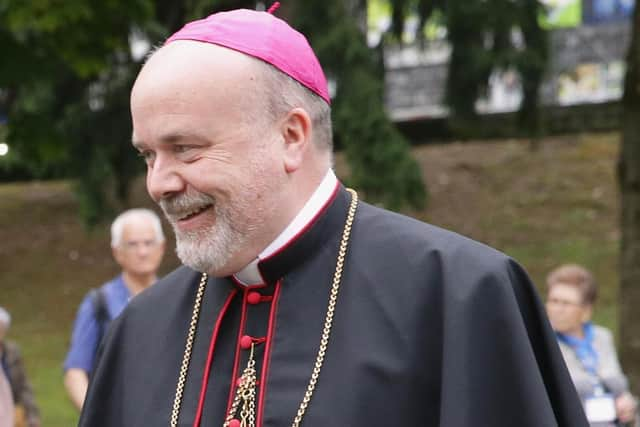Wherever you travel, may you find your heart’s desire this Christmas - Marcus Stock, Bishop of Leeds
Written around 1917, Frances’ carol imagines simple children on a journey to encounter Jesus, contrasting it with that of the clever and confident Wise Men. Painting a picture of little ones shyly asking permission to enter the starlit stable, daring to peep with the ox, ass and sheep at the sleeping Infant, timidly touching the tiny hand, as if meeting a new-born baby brother for the first time.
On this journey of the imagination, I can imagine young voices asking Mrs Chesterton ‘Are we nearly there yet?’- but Frances and her husband Gilbert ‘GK’ Chesterton were not blessed with their own children, although they themselves scampered through life as full of love, wonder, contradictions, endless questions and cheerful cheekiness as any child.
Advertisement
Hide AdAdvertisement
Hide AdUnlike the Wise Men, the children have no grand, expensive gifts to offer, only the ‘little smiles and little tears’ of everyday life. The gift of self is all God wants from any of us – but that can be a costly commitment, as travelling to meet Jesus in the manger at Bethlehem is a first step to accompanying Him onward to the cross at Calvary.


GK Chesterton once wrote ‘Christmas is built upon a beautiful and intentional paradox; that the birth of the homeless should be celebrated in every home.’ Like the rich Wise Men, or the Holy Family shivering in the poverty of a stable, we may all come from different roots, but we all share the same road and direction of travel. Frances’ paradoxical portrait of the Nativity with its darker overtones also reflects the childlike innocence combined with worldly wisdom found in her husband’s most famous literary creation, ‘Father Brown’.
The ‘Father Brown Stories’ have been made into several films, and this year the current BBC series, adapted and updated from some of Chesterton’s short stories originally written between 1910 and 1936, celebrated its 100th episode.
Here in the Diocese of Leeds, we too celebrated a centenary, as this summer was the anniversary of ‘GK’ being received into the Catholic Church in 1922 by one of our priests, Fr John O’Connor. He was the real-life inspiration for Father Brown and like his fictional counterpart, he was also canny, clever and compassionate. As priests, neither stood apart in judgement of others; both were unfazed by the weakness and wickedness of human frailty because – like all of us – they shared in it.
Advertisement
Hide AdAdvertisement
Hide AdO’Connor and Chesterton first met in Keighley where GK was on his way to visit a friend from Bradford’s German-Jewish community whom O’Connor also knew. Walking, talking and arguing together across the Moor to Ilkley, O’Connor guided GK’s first steps on the path to Rome.
Walking with another person, either literally or metaphorically, makes understanding them easier. From our first faltering, uncoordinated toddling, supported by a steady parental hand, we realise that even ‘standing on our own two feet’ does not necessarily mean walking alone; neither do we need to be fit or able bodied to accompany one another along life’s journey, lighting the way for all who walk in darkness and guiding the lost back home.
Whereas online anonymity or a limit of 280 characters leave room for much misunderstanding and confrontation, when walking alongside another person our expression, body language and tone of voice aid goodwill and a meeting of minds. We almost subconsciously fall into step, adapting our pace to the other, perhaps sharing our burdens, whether that be Christmas shopping or the heavier burdens of illness, loneliness, debt, doubt, war and worry.
The Church uses the Greek word, ‘Synod’ to convey the idea of walking together down the same path.
Advertisement
Hide AdAdvertisement
Hide AdToday, churchgoing may not be as regular as it once was, but walking to holy places on pilgrimages is increasingly popular.
Here in the Diocese of Leeds our two-day St Wilfrid’s Way between Leeds Cathedral and Ripon has become the inspiration and model for other Cathedral-to-Shrine walks in Catholic dioceses across the country.
This pilgrimage project has been called ‘Hearts in Search of God’ – because like the children in Frances Chesterton’s carol, our lives’ quests are journeys of the heart, journeys to Bethlehem.
So are we nearly there yet? Not quite. But if we travel to meet the Christ-Child this Christmas Eve, we will need no permission to enter into His presence. He will recognise even the least of us, imperfect as we are. He will know we’ve come so far, just for His sake, and will warmly welcome the weary travellers home.
Wherever you travel, may you and your loved ones go with God’s blessing and find your heart’s desire this Christmas.
The Right Reverend Marcus Stock is the Bishop of Leeds.